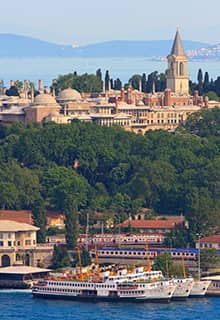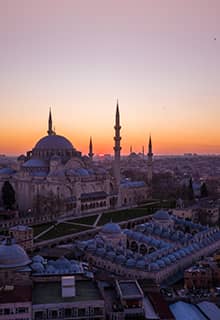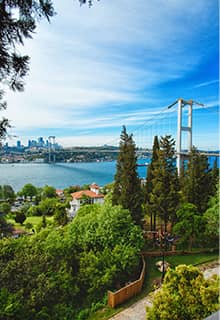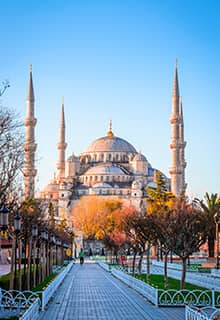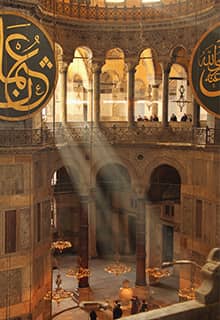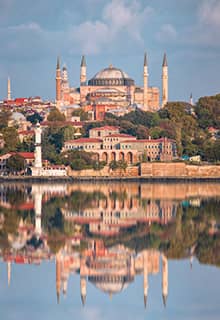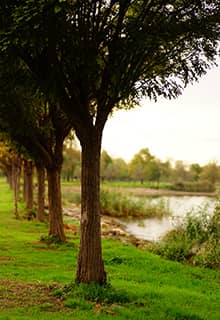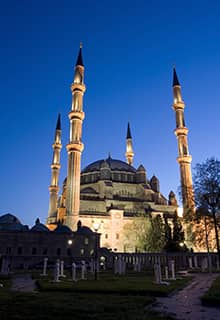

see
Marmara Türkiye
The Historical Peninsula in İstanbul
With a unique location straddling two continents Asia and Europe, İstanbul is the geographical and metaphorical bridge between the East and the West. It has been home to a vast array of different civilizations and boasts some stunning natural richness.
Historical peninsula is located on the European side of the city. Many of İstanbul's beautiful historic and religious places are here. The peninsula is home to Sultanahmet Mosque (also known as the Blue Mosque), Hagia Sophia Grand Mosque, Topkapı Palace, The Basilica Cistern, the Theodosius Obelisks, Süleymaniye Mosque, Grand Bazaar.
The Nature in Yalova
Only one-hour away from metropolises like İstanbul, Kocaeli and Bursa, Yalova is an important alternative destination in Marmara Türkiye with its nature and spa centers.
Sudüşen Waterfalls is one of the natural treasures in Yalova. When going to the waterfalls, you can see the unique dam, the magnificent panoramic view of the Marmara Sea, various flora. Don’t forget to take photographs around the waterfall. ou can also do trekking in area!
The forest in Teşvikiye offers a picturesque view to visitors. Büyük Dipsiz Göl (The Big Bottomless Lake), Küçük Dipsiz Göl (The Small Bottomless Lake) " and Erikli Plateau, ten kilometres away from Teşvikiye, are also worth seeing thanks to their unmatched views.
Lake Sapanca in Sakarya
Sakarya is full of natural treasures such as the Lake Sapanca, Acarlar Longozu (Subasar Forest) and Karasu Beach, and it has a rich cultural heritage and cuisine.
Lake Sapanca is one the places you should see! As the most visited point of the city of Sakarya, Lake Sapanca is a freshwater lake. Offering a beautiful natural environment, Sapanca is situated among hills covered in pines, hornbeams, and oaks. There are trout restaurants around the lake, and hotels that appeal to every expectation. You will also find the cafés and restaurants on the streams that feed Lake Sapanca that are popular with visitors.
The Historical Treasures in Bilecik
Bilecik, the place where the Ottoman Empire was established, also has many historical assets like the Ertuğrul Gazi (the founder of Ottoman Empire) Tomb, Şeyh Edebali Tomb, and Metristepe Victory Monument.
Bilecik also has an important place in the history of Turkish Republic as a place where the First and Second İnönü Wars (two battles of the War of Independence) took place.
A Sport Center, Kartepe in Kocaeli
Only one hour away from İstanbul, Kartepe, the highest peak of the Samanlı Mountains boasts great views of İzmit Gulf and Sapanca Lake, is an excellent place for skiers. The season generally begins at the end of December, and the skiing resort is an ideal place for congress and seminar tourism during the summer.
Kartepe, the habitat of almost 3,000 plants, deer, bear, jackal, and rabbit, is also one of the sports tourism centres of Türkiye, thanks to its tennis courts, volleyball fields, and grass football pitches which meet international FIFA standards.
The Unique Mosques in Bursa
Known as the "City of Sages", Bursa was the first capital city of the Ottoman Empire. Therefore, Bursa is home to unique historic buildings, including Ulu Mosque (Ulu Cami) and Green Mosque (Yeşil Cami).
Ulu Mosque was built during the time of Yıldırım Bayezid, the fourth sultan of Ottoman Empire, between 1396-1400. It is the first of the multi-domed monumental structures among Ottoman mosques. Ulu Mosque has 20 domes sitting on twelve large four-cornered pillars.
Green Mosque was built in 1419. It is one of the "Inverted T" planned mosques and one of the most beautiful historical buildings of Türkiye as well as Bursa.
The Sunset in Balikesir
Şeytan Sofrası (The Devil’s Table), is an excellent sunset viewpoint of Ayvalık, lovely district of Balıkesir city. The hill, which is perched over the Çamlık Forestry Camp, is an old lava cone, and the hilltop, which is flat, resembles the traditional, low, round dining tables of the region. Some believe that an imprint on the rock, now covered with an iron cage, is the footprint of the Devil. The Devil’s Table has a panoramic view over the Ayvalık archipelago, looking down onto sounds and coves covered with pine forests.
Ancient Troia in Çanakkale
The oldest settlements in Troy, which has a complex and rich archaeological structure, with 10 different city layers belonging to different periods, date back to 3,000 BC. This unique area, which had uninterrupted settlement until 500 AD, enabled the residents of the region to control all the merchant ships that sailed from the Aegean Sea to the Black Sea in that period.
Troy is an important city in understanding the early development of European civilization. The city has a cultural significance due to its contribution to Homer's Iliad and the creative art.
Located within the boundaries of Çanakkale province, on the slopes of the Kaz Mountain, Troy was declared a National Park in 1996 and was included in the UNESCO World Heritage List as a cultural asset in 1998.
Museums in Tekirdağ
Rakoczi Museum is the 3-storey traditional Ottoman house which was home to Hungarian People’s Liberation Hero Ferenc Rakoczi II from 1720 to 1735. It was restored by the Hungarian government to become a museum. The museum’s collection comprises, Rokoczi's statue documents about his life, as well as items used in that period. On the second floor, there are oil paintings of those who participated in the Hungarian independence war with Rakoczi.
Another important museum, Tekirdağ Archaeology and Ethnography Museum exhibits cultural assets dating back to the year 4500 BC. The architectural pieces from the Hellenistic, Roman and Byzantine periods, sarcophagi, tomb steles, altar stones, milestones, inscriptions from the Ottoman period, fountains and fountain mirrors, tombstones are on display in the large garden of the museum.
Masterpieces of Architecture in Edirne
Constructed by the architect Mimar Sinan between 1569 and 1575, the Selimiye Mosque and its complex are inscribed on the Unesco World Heritage List in 2011. A masterpiece of Turkish art and in the history of world architecture, the Selimiye Mosque is visible from all parts of the city with its monumental dome and four slender minarets. Besides its unique architectural characteristics, the mosque evokes admiration with its exquisite details in its carved-stonework and marble, glazed tiles, wood carving and mother-of-pearl inlays.
Little Hagia Sophia (Gazi Süleyman Paşa Mosque) in Kirklareli
It is a former Byzantine era Orthodox church built during Emperor Justinian I (reigned 527-565) times, which was converted later in the Ottoman era into a mosque. Little Hagia Sophia is situated between the inner and outer walls in the Kale neighbourhood of Vize district. It has a rectangular, almost square plan. The capitals of its marble columns are in Corinthian style. Mosaics, which are currently not present, like the columns, are similar in shape to those found in the excavation between Hagia Sophia and St. Irene.

